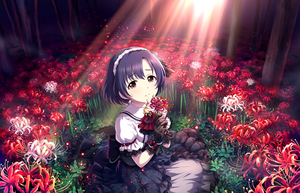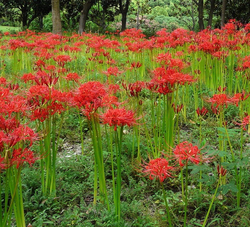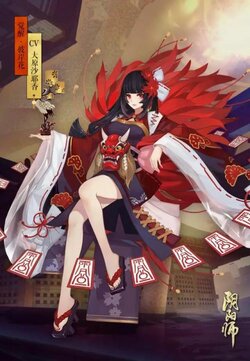Higanbana (plant)
| Higanbana | ||
Anime | ||
| Name | Higanbana | |
| Other Names | Red spider lily, Manjushage (曼珠沙華) | |
| Species | Lycoris radiata | |
| Origin | All continsnts except Antarctica, mainly Asia | |
| Characters | Flower Knight Girl:Lycoris, Onmyoji:Higanbana | |
| Works | Hell Girl, Flower Knight Girl, Onmyoji (game) | |
| Information | ||
| Domain | Eukaryote | |
| Kingdom | Plantae | |
| Subkingdom | Viridiplantae | |
| Superphylum | Spermatophyta (seed plants) | |
| Phylum | Angiospermae | |
| Subphylum | Angiospermace | |
| Class | Liliaceae (Monocotyledons) | |
| Subclass | Liliidae | |
| Order | Asparagales | |
| Family | Amaryllidaceae | |
| Genus | Lycoris | |
A higanbana (Japanese:
It is also known as the red spider lily, or as manjushage (曼珠沙華) in Japanese.
Higanbana and higanbana-based things appear frequently in ACGN works.
Contents
Introduction
In the narrow sense, higanbana specifically refers to a particular species of the Lycoris genus of Amaryllidaceae, and in the broad sense, it is a general term for the genus Lycoris. The red spider lily is a variant of Lycoris.
The name "Higanbana" is named after the legend that the flower (mostly referring to the red spider lily) was born on the other side of the Styx River. The transliteration is "Manjushage", which is derived from the Sanskrit "Majusaka".
The plant of Lycoris is a perennial herb with nearly spherical bulbs underground, long and narrow ribbon leaves, and flowers in umbels.
Lycoris is native to the Yangtze River Basin in China and is cultivated in most parts of the world except Antarctica, and is more common in Southwest China and Japan.
Wild Lycoris (higanbana) mainly grows in rivers, streams and some hilly areas in dark, humid, acidic and fertile soils, and is resistant to cold and heat.
Higanbana in human culture
- The higanbana is an ornamental flower, which can be used as a potted plant or in a garden, and is often artificially planted as a garden scenery.
- According to legend, the red higanbana grows on the other side of the Styx River (the river of the underworld, the river of Huangquan, the river of hell, and the three-way river) and the roadside of Huangquan. Therefore, in works involving the underworld, hell, and the world of demons, it is common to see the appearance of higanbana. There are many versions of the legend.
- According to Japanese legend, the higanbana is a flower that voluntarily threw itself into hell and was banished back to the world, but was still reluctant to leave and wandered on the Yellow Spring Road.
- It is said that red and white flowers grow in hell and heaven respectively. There is also a saying that the mandala grows on the road of heaven, and the higanbana grows on the road of hell, representing the two endings after death: rebirth and depravity.
- The bulbs of Lycoris are poisonous and can cause vomiting, diarrhea and other symptoms, but can be eaten after processing.
- In traditional Chinese medicine, safflower Lycoris can be used as medicine for expectorant, detoxification, swelling, pain relief, and anti-cancer.
- In the flower language, the higanbana can symbolize abandonment or sad memories.
Higanbana in ACG
- For characters themed after the higanbana, see Category:Higanbana.
Biological

- Hell Girl: The surroundings of the Hell Studio and the banks of the Styx River (Santu River) are full of higanbana. In addition, the higanbana is also the representative flower of Ai Enma.
- Kimetsu no Yaiba: In the anime, higanbana appear frequently, and are also an important clue to the story. According to the information left by the doctor, Muzan Kibutsuji must find a blue higanbana in order to see the light again. What's interesting is that the blue higanbana, which was impossible to find before his death, was discovered by the descendant of Inosuke Hashibira after decades of time.
- Yoshiwara Higanbana: The heroine, Chihaya (Rin), meets Sakurawaya Tokiyu in a sea of higanbana during her childhood, and by this chance, they form an inseparable bond. In addition, the appearance of higanbana in the game also suggests the tragic ending of both.
- Touhou Project: There are higanbana in full bloom in the area of the Missing Tomb. (Perfect Memento in Strict Sense states that there are cherry blossoms called "Purple Cherry Blossoms" in Wuyuan Tomb, while Curiosities of Lotus Asia mentions that there are higanbana on the Tomb)
- Kantai Collection: There are 8 higanbana on the ship of Night Strait Hime.
- Onmyoji: There is a sea of higanbana in the Underworld, and it is the home of the yōkai Higanbana.
- Inuyasha: The anime's first ending, "My will", features some higanbana.
Anthropomorphic
- Flower Knight Girl: Lycoris, Nerine, and their variants Lycoris (Miko), Nerine (Bride), and Nerine (Christmas).
- Onmyoji: The character Higanbana.
- Kantai Collection: Lycoris Seiki is based on the higanbana and has these flowers on her head.
- Puella Magi Madoka Magica: When the witch Homura Akemi turned into the "Witch of the Nutcracker", a large number of higanbana appeared, and the witch's thoughts of God turned into higanbana blooming on the top of her head.
- Rance series: Millie Lincle wears a higanbana on her head.
- Yu-Gi-Oh: The Trickster Lycorissica card is based on the manjushage.
- αrtist5: Lycoris Muse is represented by the manjushage.
| ||||||||||||||||||||||||||||||||||||||||||||||||||||||||||||||||||||||||||||||||||||||||||||||||||||||||||||||||||||||||||||||||||||||||||||||||||||||||||


